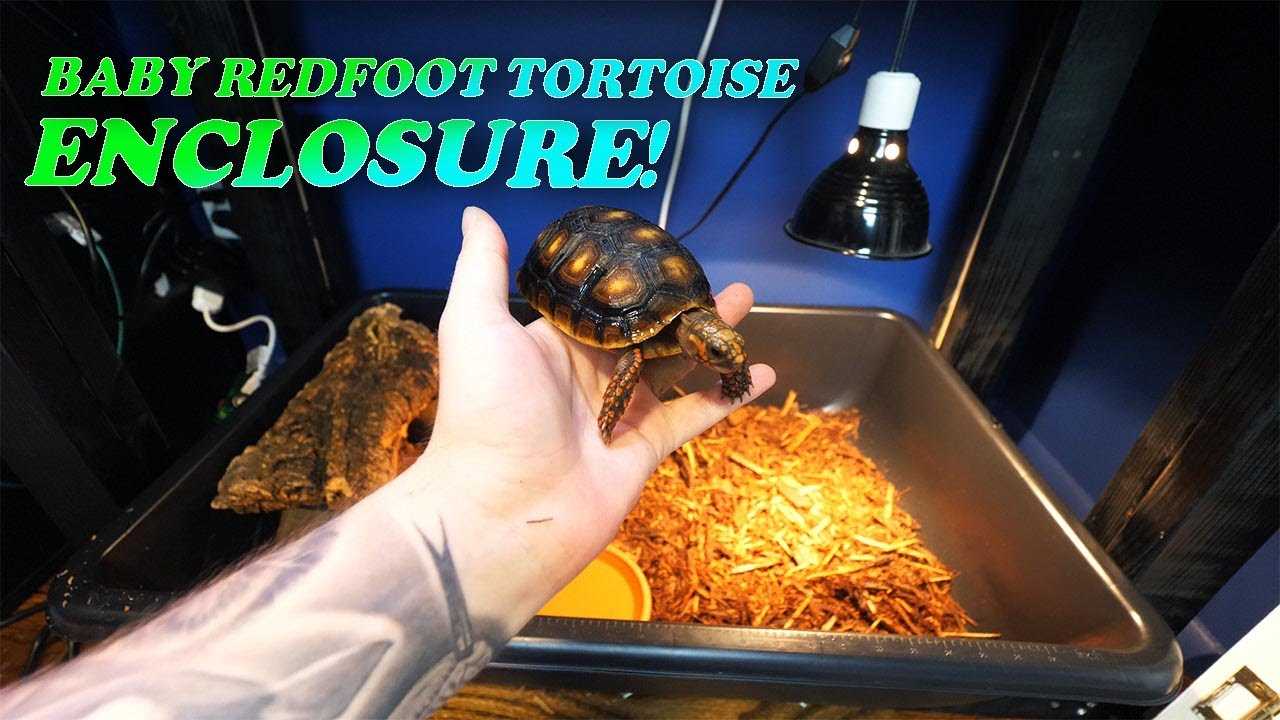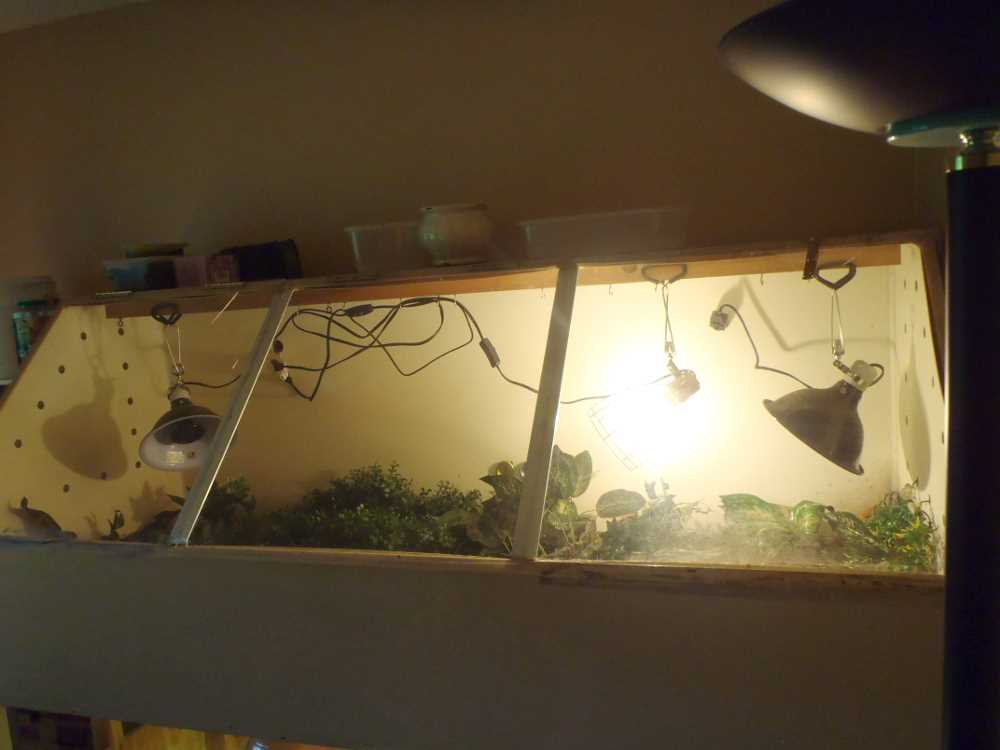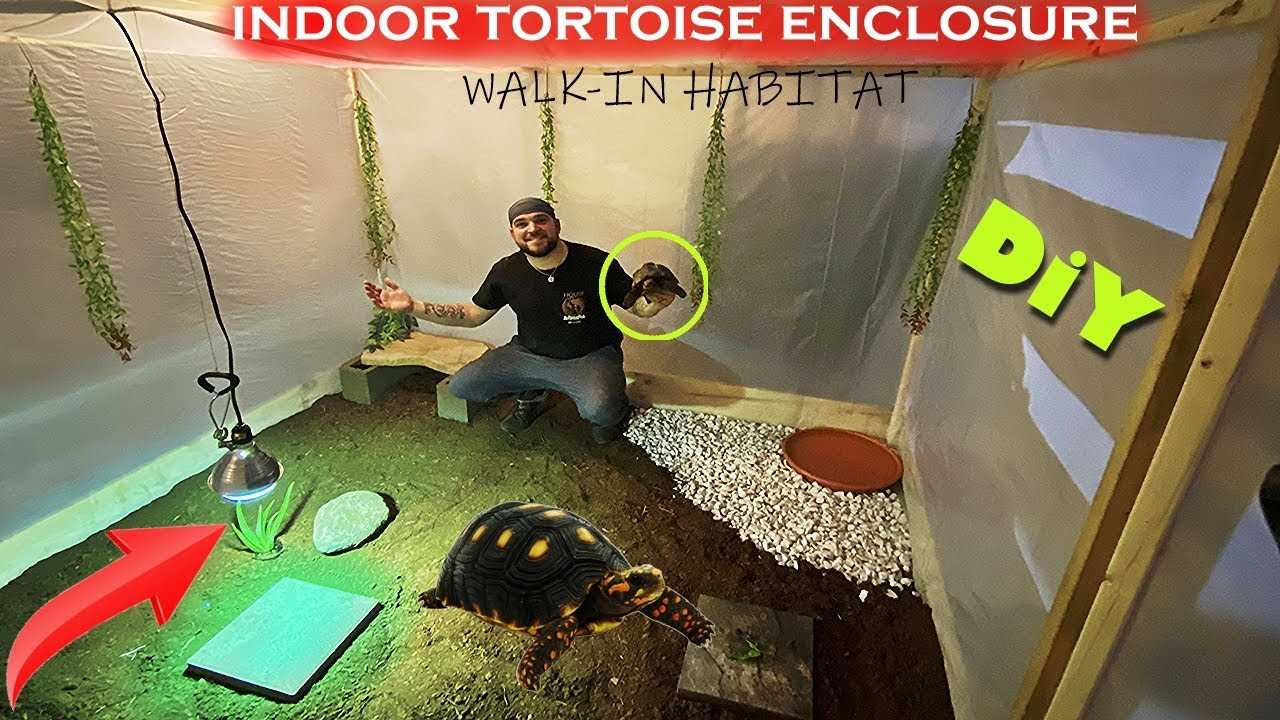
Size: Red foot tortoises need ample space to move around and explore. The size of the enclosure should be large enough to accommodate their natural behavior and activities. A minimum size of 4 feet long by 2 feet wide is recommended for an adult red foot tortoise.
Temperature and Humidity: Red foot tortoises require a warm and humid environment to thrive. The enclosure should have a basking spot with a temperature ranging from 80 to 90°F (26-32°C) and a cooler area with a temperature around 75°F (24°C). Humidity levels should be maintained between 50% and 70% to keep their skin healthy and prevent respiratory issues.
Enrichment and Hiding Places: Red foot tortoises are curious creatures and they enjoy exploring their surroundings. Providing them with various hiding places, such as rocks, logs, and plants, allows them to feel safe and stimulated. Additionally, incorporating natural elements like branches and leaves can encourage natural behaviors and create a more engaging environment.
By carefully considering these factors and creating an indoor enclosure that meets the specific needs of red foot tortoises, you can ensure that your pet tortoise is happy, healthy, and able to thrive in its environment.
The Ideal Indoor Enclosure for Red Foot Tortoises
First and foremost, the size of the enclosure is crucial. Red foot tortoises require ample space to roam and explore, so a larger enclosure is always better. Aim for a minimum size of 8 square feet for one tortoise, and add an extra 4 square feet for each additional tortoise.
In terms of substrate, avoid using any type of sand or gravel, as red foot tortoises can ingest it and develop impactions. Instead, opt for a mix of organic soil and coconut coir for a natural feel. Adding leaf litter and branches can also provide hiding spots and enrichment for the tortoises.
Lastly, don’t forget to include a shallow water dish for the tortoises to soak in. Red foot tortoises enjoy soaking in water, and it also helps to maintain their hydration levels.
Overall, creating the ideal indoor enclosure for red foot tortoises requires careful consideration of their natural habitat and needs. By providing a spacious enclosure, appropriate temperature and humidity levels, suitable substrate, and various hideouts, you can ensure that your red foot tortoises are happy and thriving in their indoor home.
Choosing the Right Environment for an Indoor Red Foot Tortoise Enclosure
Temperature

The temperature inside the enclosure should mimic the natural habitat of the red foot tortoise. These tortoises originate from the tropical regions of South America, so they require a warm environment. The ideal temperature range is between 80-85°F (27-29°C) during the day and slightly cooler at night, around 75-80°F (24-27°C).
Humidity
Red foot tortoises require a humid environment to keep their skin and shell healthy. The humidity level inside the enclosure should be around 60-80%. This can be achieved by misting the enclosure with water daily and providing a shallow water dish for the tortoise to soak in.
Using a hygrometer to measure the humidity level inside the enclosure is important to ensure it stays within the appropriate range. If the humidity is too low, a humidifier or a reptile fogger can be used to increase the moisture level. On the other hand, if the humidity is too high, providing proper ventilation will help to lower it.
Lighting
Proper lighting is essential for the health of your red foot tortoise. They require both UVB and UVA light to synthesize vitamin D3 and maintain proper calcium metabolism.
An appropriate UVB lamp should be installed in the enclosure, providing the required UVB intensity for the tortoise. This lamp should be on for 10-12 hours a day. Additionally, a UVA or full-spectrum light should also be provided to simulate natural daylight and promote the tortoise’s normal behavior.
Creating a Comfortable Indoor Enclosure for Red Foot Tortoises
Choosing the Right Enclosure
Providing the Right Substrate
Creating a Natural Habitat
Maintaining the Enclosure
Regular maintenance is necessary to keep your indoor enclosure clean and comfortable for your red foot tortoise. This includes spot cleaning the substrate regularly, removing any waste or uneaten food. The enclosure should be thoroughly cleaned and disinfected on a regular basis. It is also important to provide fresh water and clean food dishes daily.
Providing the Perfect Diet for Red Foot Tortoises
Plant Matter
The majority of a red foot tortoise’s diet should consist of plant matter. Leafy greens such as kale, collard greens, and dandelion greens should make up a large portion of their diet. These greens provide essential vitamins and minerals that are necessary for their overall health.
Protein Sources
While plant matter should make up the majority of their diet, red foot tortoises also require sources of protein. This can be provided through insects such as mealworms, crickets, and earthworms. These can be fed to them live or as a supplement in their diet.
Supplements
In order to ensure that red foot tortoises receive all the necessary vitamins and minerals, it may be necessary to provide them with supplements. Most commonly, calcium and vitamin D3 supplements are given. These can be sprinkled onto their food or provided in the form of a cuttlebone.
Feeding Schedule
It is also important to provide fresh water for drinking and soaking on a daily basis. Red foot tortoises require access to water in order to stay hydrated and aid in digestion.
| Plant Matter | Protein Sources | Supplements |
|---|---|---|
| Kale | Mealworms | Calcium |
| Collard greens | Crickets | Vitamin D3 |
| Dandelion greens | Earthworms | |
| Lean meats (cooked) |
Ensuring Proper Temperature and Humidity for Red Foot Tortoise Enclosures

When creating the perfect indoor enclosure for red foot tortoises, it is crucial to ensure that the temperature and humidity levels are appropriate for their needs. Red foot tortoises are native to tropical and subtropical regions, so replicating their natural environment is essential in order to help them thrive.
Humidity is another important factor to consider when creating the ideal environment for red foot tortoises. These tortoises require a humidity level of around 60% to 80% in their enclosure. This can be achieved by misting the enclosure with water daily and providing a shallow water dish for the tortoise to soak in. Using a hygrometer can help accurately measure and maintain the humidity level.
Proper ventilation is also necessary to prevent the build-up of excess moisture in the enclosure. This can be achieved by providing adequate airflow through the use of ventilation fans or by opening windows when weather permits.
Additionally, providing a hiding spot or a sheltered area within the enclosure is essential for red foot tortoises. This can be in the form of a cave-like structure or a hideout made from natural materials. These hiding spots provide the tortoises with a sense of security and privacy, which is important for their overall well-being.
Offering Adequate Hideouts for Your Red Foot Tortoise
Creating a comfortable and enriching environment for your red foot tortoise is essential for its well-being. One important aspect of their enclosure is providing adequate hideouts, allowing them to feel secure and have a designated space for rest and privacy.
There are several options for hideouts that you can incorporate into your tortoise’s indoor enclosure. Here are some recommendations:
1. Natural Hiding Places:
Incorporating natural elements into your tortoise’s enclosure can help create a more realistic and stimulating environment. You can use hollow logs, bark, rocks, or dense vegetation to provide natural hiding places for your red foot tortoise.
2. Commercial Hides:
There are various commercially available hides specifically designed for reptiles, including tortoises. These hides usually come in different sizes and shapes to accommodate tortoises of all ages and sizes. Make sure to choose a hide that is large enough for your red foot tortoise to comfortably fit inside.
3. DIY Hideouts:
If you are feeling creative, you can also create your own hideouts using household items or materials found in nature. For example, you can stack up terracotta pots or use PVC pipes to create tunnels for your tortoise to explore and hide in.
When placing hideouts in your tortoise’s enclosure, make sure to distribute them evenly throughout the space. This allows your red foot tortoise to have multiple hideouts to choose from and prevents dominance behaviors from developing if you have more than one tortoise.
Remember to regularly check and clean the hideouts to ensure they remain safe and hygienic for your red foot tortoise. This involves removing any old bedding or debris and replacing it with fresh substrate.
By providing adequate hideouts in your red foot tortoise’s indoor enclosure, you are giving them a sense of security and privacy, which is important for their overall well-being and happiness.
Regular Health Checkups and Maintenance for Indoor Enclosures of Red Foot Tortoises
Regular health checkups and maintenance are crucial for maintaining the well-being of red foot tortoises housed in indoor enclosures. By implementing a routine checkup and maintenance schedule, tortoise owners can ensure that their pets remain healthy and happy.
Why Regular Health Checkups and Maintenance are Important
Regular health checkups allow owners to monitor the overall health of their red foot tortoises. During checkups, veterinarians can identify any potential health issues or concerns and provide appropriate treatment or advice. It is recommended to schedule checkups at least once a year or more frequently if necessary.
Regular maintenance of the indoor enclosure is equally important. A clean and well-maintained habitat promotes a healthy environment for the tortoise, preventing the formation of bacteria, mold, and other harmful substances. It also helps maintain proper temperature, humidity, and cleanliness.
Components of Regular Health Checkups and Maintenance
During regular health checkups, veterinarians will typically assess the tortoise’s overall body condition, weight, and shell health. They may also check for signs of parasites and inspect the eyes, mouth, and limbs for any abnormalities.
Regular maintenance of the indoor enclosure includes cleaning and sanitizing the habitat, checking the temperature and humidity levels, and ensuring the proper functioning of any heating or lighting equipment. It is also important to regularly inspect and replace any worn-out or damaged items, such as bedding, hides, or feeding dishes.
Tips for Ensuring Regular Health Checkups and Maintenance
Here are some tips to help tortoise owners ensure regular health checkups and maintenance:
- Establish a relationship with a reputable reptile veterinarian who specializes in tortoises.
- Follow the recommended checkup schedule provided by the veterinarian.
- Keep a record of the tortoise’s health and any observations or concerns for each checkup.
- Regularly clean and sanitize the enclosure, following proper guidelines provided by the veterinarian.
- Monitor the temperature and humidity levels of the enclosure to ensure they are within the appropriate range.
- Inspect the enclosure and its components regularly for any signs of damage, wear, or potential hazards.
- Provide a balanced and nutritious diet for the tortoise to support its overall health.
By prioritizing regular health checkups and maintenance, owners can ensure that their red foot tortoises thrive in their indoor enclosures and enjoy a healthy, fulfilling life.

I’m Lena Adams—a product of an unconventional upbringing in the African wilderness. My father, a daring explorer of African wildlife, sparked my fascination with reptiles, a passion that intertwined with the tragic loss of my mother during an expedition, leaving an indelible mark on my life. Driven to understand the creatures that captivated my parents, I embarked on my journey, sharing insights about reptiles, frogs, and lizards on my website. Through my explorations and conservation efforts, I honour my family’s legacy while seeking connections—to the creatures, nature, and the mother whose presence I yearn to understand.
